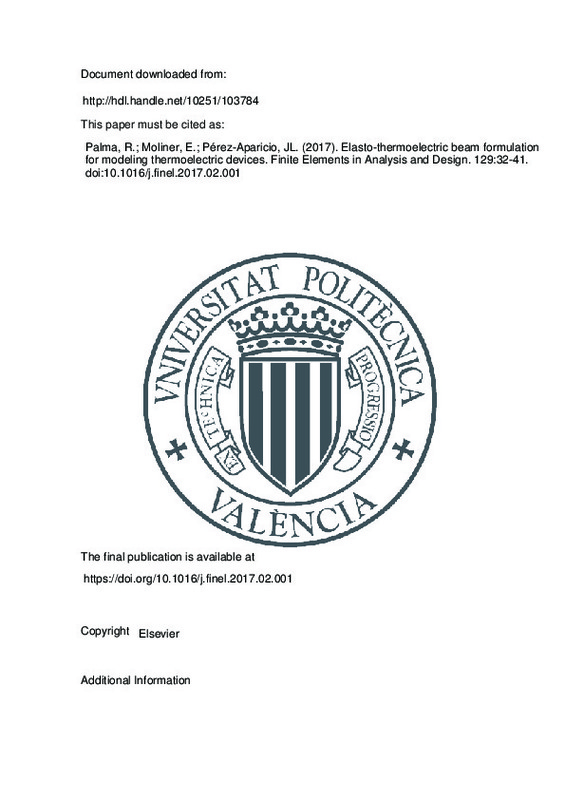JavaScript is disabled for your browser. Some features of this site may not work without it.
Buscar en RiuNet
Listar
Mi cuenta
Estadísticas
Ayuda RiuNet
Admin. UPV
Elasto-thermoelectric beam formulation for modeling thermoelectric devices
Mostrar el registro sencillo del ítem
Ficheros en el ítem
| dc.contributor.author | Palma, Roberto
|
es_ES |
| dc.contributor.author | Moliner, E.
|
es_ES |
| dc.contributor.author | Pérez-Aparicio, José L.
|
es_ES |
| dc.date.accessioned | 2018-06-11T04:29:07Z | |
| dc.date.available | 2018-06-11T04:29:07Z | |
| dc.date.issued | 2017 | es_ES |
| dc.identifier.issn | 0168-874X | es_ES |
| dc.identifier.uri | http://hdl.handle.net/10251/103784 | |
| dc.description.abstract | [EN] The present paper provides a dynamic, non-linear and fully coupled Finite Element (FE) formulation based on the Timoshenko beam theory to study elasto-thermoelectric responses in thermoelectric devices. The two main motivations of this work are: i) to study mechanical responses in thermoelectric devices, which must be taken into account in the design of Peltier cells due to the fragility and relative low strength of the semiconductors, and ii) to provide a numerical tool that decreases the CPU time to allow the introduction of designs based on optimization processes and on sensitivity analyses that could require many evaluations. In order to undertake the objectives of this work, the general three-dimensional governing equations are reduced to one-dimensional ones by means of several assumptions. Then, a set of five multi-coupled partial differential equations is obtained. The resultant expressions are thermodynamically consistent and form a multi-coupled monolithic FE formulation, differently to stagger formulations that require two separated steps to reach the final result. Numerically, this set of multi-coupled equations is discretized using the FE method and implemented into FEAP Taylor, 2010 [1]. For a proper validation of the code, four benchmarks are performed using one- dimensional dynamic analytical solutions developed by the authors. Finally, this formulation is compared with a three-dimensional FE formulation also developed by the authors in Pe ́rez-Aparicio et al., 2015 [2] to model a commercial Peltier cell. This comparison reveals that: i) relative errors are lower than 13% and ii) CPU times decrease significantly, more than one order of magnitude. In conclusion, the beam thermoelectric formulation is an accurate model that reduces CPU time and could be used in future design of thermoelectric devices. | es_ES |
| dc.language | Inglés | es_ES |
| dc.publisher | Elsevier | es_ES |
| dc.relation.ispartof | Finite Elements in Analysis and Design | es_ES |
| dc.rights | Reserva de todos los derechos | es_ES |
| dc.subject | Thermoelectric | es_ES |
| dc.subject | Timoshenko beam model | es_ES |
| dc.subject | Finite Element Method | es_ES |
| dc.subject | Thermodynamics, Peltier cells | es_ES |
| dc.subject.classification | MECANICA DE LOS MEDIOS CONTINUOS Y TEORIA DE ESTRUCTURAS | es_ES |
| dc.title | Elasto-thermoelectric beam formulation for modeling thermoelectric devices | es_ES |
| dc.type | Artículo | es_ES |
| dc.identifier.doi | 10.1016/j.finel.2017.02.001 | es_ES |
| dc.rights.accessRights | Abierto | es_ES |
| dc.date.embargoEndDate | 2019-07-01 | es_ES |
| dc.contributor.affiliation | Universitat Politècnica de València. Departamento de Mecánica de los Medios Continuos y Teoría de Estructuras - Departament de Mecànica dels Medis Continus i Teoria d'Estructures | es_ES |
| dc.description.bibliographicCitation | Palma, R.; Moliner, E.; Pérez-Aparicio, JL. (2017). Elasto-thermoelectric beam formulation for modeling thermoelectric devices. Finite Elements in Analysis and Design. 129:32-41. doi:10.1016/j.finel.2017.02.001 | es_ES |
| dc.description.accrualMethod | S | es_ES |
| dc.relation.publisherversion | https://doi.org/10.1016/j.finel.2017.02.001 | es_ES |
| dc.description.upvformatpinicio | 32 | es_ES |
| dc.description.upvformatpfin | 41 | es_ES |
| dc.type.version | info:eu-repo/semantics/publishedVersion | es_ES |
| dc.description.volume | 129 | es_ES |
| dc.relation.pasarela | S\327237 | es_ES |







![[Cerrado]](/themes/UPV/images/candado.png)

